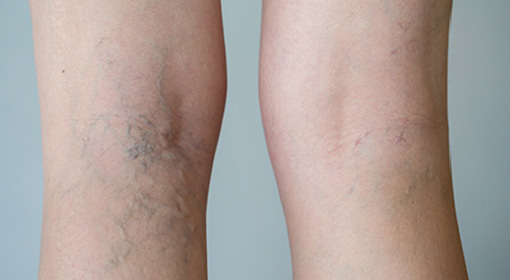
Varicose veins are enlarged veins that can be blue, red or flesh colored.  They are often above the skin on legs and look like twisted bulging cords. Varicose veins occur when the valves that carry blood from the legs toward the heart no longer function, causing blood to pool and the veins to enlarge. Untreated varicose veins typically enlarge and worsen. Varicose veins can progress to chronic venous insufficiency (CVI) especially when swelling and skin changes become evident.  This becomes a more serious condition.
Risk factors for the development of varicose veins include a family history of varicose veins, female gender, increased number of pregnancies, premenstrual leg aches or cramps, being overweight, a sedentary life style, occupations that require prolonged sitting or standing and  increasing age as the most common.
Varicose veins are enlarged veins that can be blue, red or flesh colored.  They are often above the skin on legs and look like twisted bulging cords. Varicose veins occur when the valves that carry blood from the legs toward the heart no longer function, causing blood to pool and the veins to enlarge. Untreated varicose veins typically enlarge and worsen. Varicose veins can progress to chronic venous insufficiency (CVI) especially when swelling and skin changes become evident.  This becomes a more serious condition.
Risk factors for the development of varicose veins include a family history of varicose veins, female gender, increased number of pregnancies, premenstrual leg aches or cramps, being overweight, a sedentary life style, occupations that require prolonged sitting or standing and  increasing age as the most common.
Spider veins, like varicose veins, are caused by dysfunctional vein valves.
View DetailsCVI is a progressive medical condition in which venous valves that help carry blood from the legs to the heart no longer function,
View DetailsDeep vein thrombosis (DVT) is a blood clot that forms in a vein deep in the body.
View DetailsHealthy leg veins contain valves that allow blood to move in one direction from the lower limb toward the heart.
View Details